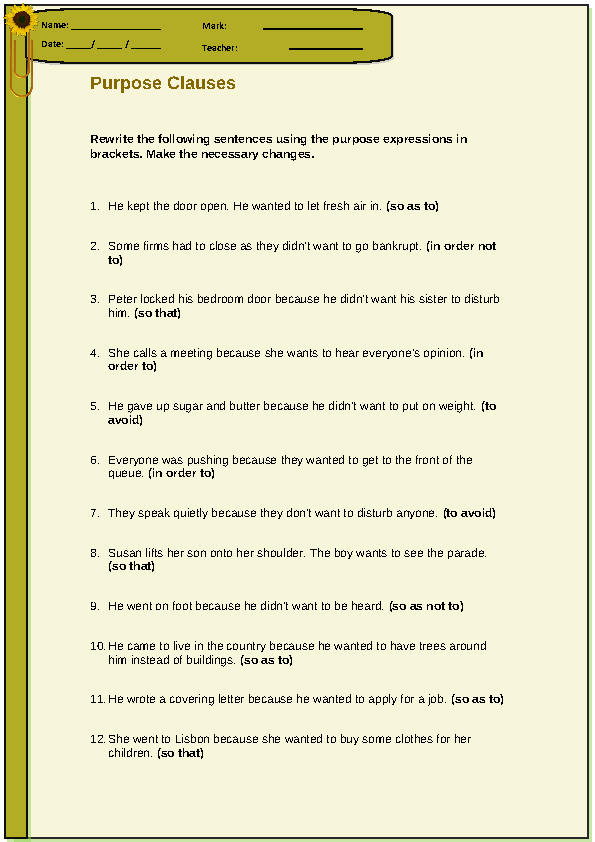Adverb Clause Of Purpose Worksheet – An adverb describes a verb. Adverbs can be used to signal the place, time and manner of something being performed. They are often placed after the adjective, verb or adverb that they modify.
Here are some examples.
He ran quickly.
She sang beautifully.
They speak fluent English.
There are a variety of options for creating adjectives. As you can observe, there are many ways to create an adverb. As you can see, other adverbs can be created by using different words together.
He drives slowly.
He arrived on time.
Adverbs can either be placed at the start or end of a sentence. The purpose of the adverb determines its position.
It is evident that adverbs that modify verbs should be placed following the verb. Adverbs that alter adjectives, as well as other adverbs, should be placed prior to the adjective or other anagram it is changing.
For example,
He is an inefficient driver. (incorrect)
He is a slow driver. (correct)
He drives slowly. (correct)
They were there quickly. (correct)
They showed up quickly. (incorrect)
Learn more about the adverbs. These worksheets allow students to learn how to use adverbs within sentences. These worksheets are divided into three sections: understanding and using adverbs and forming Adverbs.
You will need to look at several sentences and highlight the adverbs in each one. This section will help you identify the adverbs. The second section, Adverbs, will help you practice using adverbs to recognize the adjectives and verbs. The third part will guide you on how to transform adjectives to adverbs.
Are you ready to get started? These worksheets on adverbs are very simple to utilize. Get a pencil.
Adverb Worksheets Types and Uses
An adverb can be used to define a verb, adjective or other word. Adverbs are used to describe what, where, when and why it was done. For instance, adverbs are typically placed after an adjective.
He walked slowly around the room.
For example, you can create most adjectives by adding a ‘ly’ following an adjective.
Adjective Slow
Adverb: slowly
Adjective: quick
Adverb: quickly
Adjective: hard
Adverb: Hard
Adverbs can be either one-word or multi-word. A good example of a one-word adjectival is the –ly form.
He slowly moved through the space.
Multi-word adjectives consist of multiple words, such:
He walked slowly through the room.
These are some commonly used multi-word adverbs:
adverb + adverb: quite slowly, extremely quickly
Adverb + adjective
Preposition + adverb = Without delay, at the front
There are two kinds of adverbs.
1. Adverbs that describe how
The fashion adjectives explain the way something is done. Let’s look at this example:
Slowly, he walked through the room.
The words slowly reveal the way he moved.
There are only a handful of examples, but they provide a description of the process.
You can talk loudly or fast.
2. Place-related Adverbs
Adverbs of place can be used to identify the place of something. For instance:
He moved about the room.
The adverb that is used in this sentence tells us the direction he walked.
These are only two examples of adverbs that refer to places.
Outside and upstairs, downstairs and nothing other than that
Adverbs are also available which refer to frequency or time. Adverbs that refer to frequency or time can be used to signify when something has been done.
Slowly, he walked through the room.
The sentence is based on the slow adjectival.
Adverb Worksheets Tips and Tips and
Adverbs may be words that modify the meaning of a verb or adjectives. These worksheets allow you to show your students the numerous applications of adjectives. Here are some helpful strategies and tips to make the most of your adverb worksheets.
1. There are many sentences that you can make.
Adverbs can be used to create many different sentences. It is best to experiment with it and apply it in conjunction with your worksheets. It is possible to use simple sentences or more complex sentences. This will enable your students to comprehend how adverbs can be used in different ways.
2. To highlight, use the adjectives
When you are creating worksheets for students, make sure you note the adverbs you use within each sentence. This makes it easier for your students to recognize them. You can highlight all the adjectives with one color, or use another color to signify each sentence.
3. Allow students to write their own sentences.
Your students should not only complete the blanks on their worksheets, but they should also write sentences with adjectival words. They will be better able to understand the usage of adverbs while writing.
FAQs on Adverb Worksheets
1. What are adjectives?
Adverbs are used to describe an adjective, verb, or another word. Adverbs are used to indicate the time, place, and how something is done. These often end in the suffix -ly.
2. What are the most frequently used adverbs?
There are four types.
3. What can I do with adverbs to enhance my writing?
Adverbs are used to describe verbs and adjectives. These adverbs are a great way to enhance your writing.
4. What are the most common adjectives?
Common adverbs: quickly slow; slowly; poorly; well; hard and soft earlier and later Never, never; sometimes, but often.





